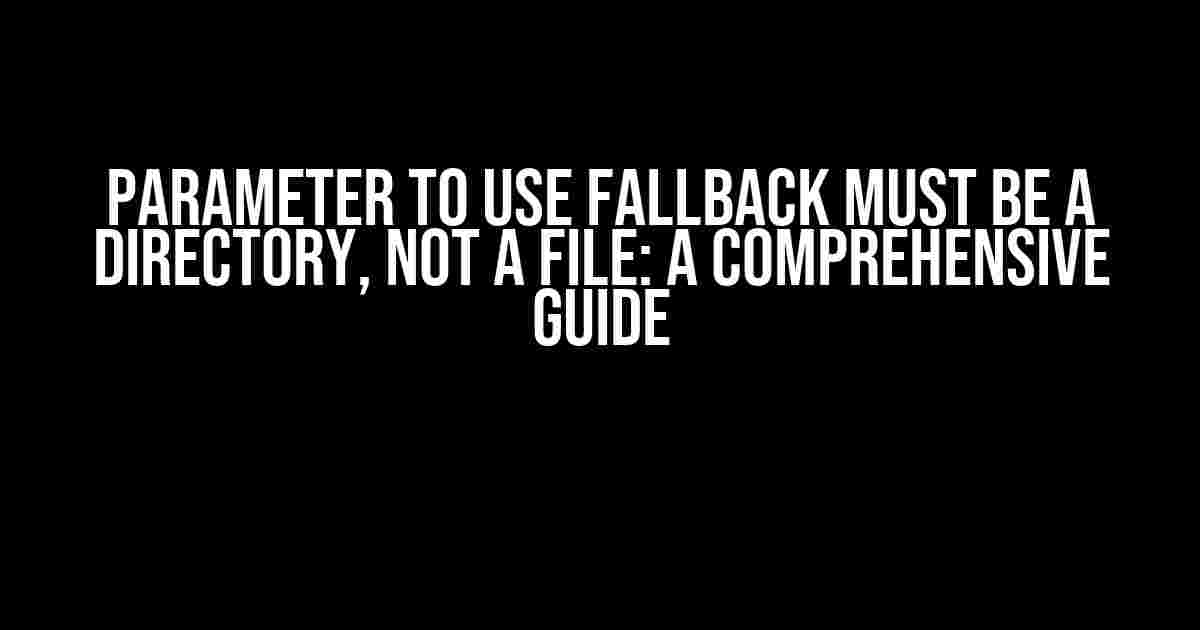Are you tired of encountering the annoying “Parameter to use fallback must be a directory, not a file” error message? Do you want to learn how to resolve this issue once and for all? Look no further! In this article, we’ll delve into the world of fallback parameters, directories, and files, and provide you with a step-by-step guide on how to overcome this frustrating error.
What is a Fallback Parameter?
A fallback parameter is a mechanism used in various programming languages and frameworks to provide a default value or behavior when a primary parameter is not available or fails. In other words, a fallback parameter is a safety net that ensures your application or script continues to function even when the primary parameter is missing or faulty.
Why Do We Need Fallback Parameters?
Fallback parameters are essential in various scenarios, such as:
- Handling missing or corrupted data
- Providing default values for optional parameters
- Ensuring backwards compatibility with older versions
- Improving application resilience and fault tolerance
The Error Message: “Parameter to Use Fallback Must Be a Directory, Not a File”
So, what happens when you encounter the “Parameter to use fallback must be a directory, not a file” error message? Simply put, this error occurs when you’re trying to use a file as a fallback parameter instead of a directory.
This error can occur in various programming languages and frameworks, including but not limited to:
- Python
- Java
- Node.js
- Ruby
Why Does This Error Occur?
This error occurs because fallback parameters require a directory path, not a file path. A directory path provides a collection of files or subdirectories that can be used as a fallback, whereas a file path specifies a single file that cannot be used as a fallback.
For example, in Python, if you’re using the `os` module to specify a fallback directory, you might write:
import os
fallback_dir = '/path/to/fallback/directory'
if not os.path.exists(fallback_dir):
fallback_dir = '/path/to/default/fallback/directory'In this example, `fallback_dir` is a directory path that provides a collection of files or subdirectories that can be used as a fallback. If `fallback_dir` doesn’t exist, the code falls back to the default fallback directory specified by the second `fallback_dir` variable.
How to Resolve the Error: Step-by-Step Instructions
Resolving the “Parameter to use fallback must be a directory, not a file” error is relatively straightforward. Follow these step-by-step instructions to ensure you’re using a directory as a fallback parameter:
-
Check Your Code: Review your code and identify the line of code that’s causing the error. Look for any instances where you’re using a file path instead of a directory path.
-
Specify a Directory Path: Update your code to specify a directory path instead of a file path. Make sure the directory path is correct and points to a valid directory.
-
Use a Directory Object: If you’re working with a programming language that supports directory objects (e.g., Python’s `os` module), use a directory object to specify the fallback directory. This ensures that you’re working with a directory path rather than a file path.
-
Verify Directory Existence: Verify that the fallback directory exists and is accessible. You can do this by using functions or methods that check for directory existence, such as Python’s `os.path.exists()` function.
-
Test Your Code: Once you’ve updated your code, test it thoroughly to ensure the error is resolved.
Best Practices for Working with Fallback Parameters
To avoid encountering the “Parameter to use fallback must be a directory, not a file” error, follow these best practices when working with fallback parameters:
-
Use Clear and Consistent Naming Conventions: Use clear and consistent naming conventions for your fallback parameters and directories. This helps avoid confusion and ensures that you’re working with the correct directory paths.
-
Validate User Input: Validate user input to ensure that the fallback parameter is a directory path and not a file path.
-
Use Robust Error Handling: Implement robust error handling mechanisms to catch and handle errors related to fallback parameters.
-
Test Thoroughly: Test your code thoroughly to ensure that it works correctly with different scenarios and edge cases.
Common Pitfalls to Avoid
When working with fallback parameters, it’s essential to avoid common pitfalls that can lead to errors. Here are some common pitfalls to avoid:
| Pitfall | Description |
|---|---|
| Using file paths instead of directory paths | This is the most common pitfall that leads to the “Parameter to use fallback must be a directory, not a file” error. |
| Not validating user input | Failing to validate user input can lead to errors and security vulnerabilities. |
| Not testing thoroughly | Failing to test your code thoroughly can lead to errors and bugs that are difficult to debug. |
| Not using robust error handling | Failing to implement robust error handling mechanisms can lead to application crashes and errors. |
Conclusion
In conclusion, the “Parameter to use fallback must be a directory, not a file” error is a common issue that can be resolved by following the step-by-step instructions outlined in this article. By understanding the concept of fallback parameters, specifying directory paths, and following best practices, you can avoid this error and ensure your application or script works correctly.
Remember, fallback parameters are an essential mechanism for providing default values and behaviors in programming. By using them correctly, you can improve the resilience and fault tolerance of your application, making it more robust and reliable.
Final Thoughts
In the world of programming, errors are an inevitable part of the development process. However, by following best practices, testing thoroughly, and using robust error handling mechanisms, you can minimize the occurrence of errors and ensure your application or script works correctly.
Don’t let the “Parameter to use fallback must be a directory, not a file” error hold you back from creating amazing applications and scripts. With the knowledge and skills outlined in this article, you’re well-equipped to overcome this error and take your programming skills to the next level.
Happy coding!
Frequently Asked Questions
Get answers to the most commonly asked questions about the error “Parameter to use fallback must be a directory, not a file”.
What does the error “Parameter to use fallback must be a directory, not a file” mean?
This error occurs when you’re trying to use a file as a fallback parameter instead of a directory. Fallback parameters require a directory path to function correctly, and using a file path will result in this error.
How do I fix the “Parameter to use fallback must be a directory, not a file” error?
To fix this error, simply replace the file path with a directory path. Make sure the directory exists and has the necessary permissions to be used as a fallback parameter. If you’re still encountering issues, check your code for any typos or incorrect path references.
Why does the fallback parameter require a directory instead of a file?
The fallback parameter requires a directory because it needs to store and retrieve files dynamically. A directory provides a container for these files, allowing the system to manage them efficiently. A file, on the other hand, is a single entity that cannot be used as a container for other files.
Can I use a symbolic link to a directory as a fallback parameter?
Yes, you can use a symbolic link to a directory as a fallback parameter. However, make sure the symbolic link points to a valid directory and not a file. The system will follow the symbolic link to the target directory, allowing the fallback parameter to function correctly.
What are the consequences of ignoring the “Parameter to use fallback must be a directory, not a file” error?
If you ignore this error, your system may malfunction or produce unexpected results. In some cases, it can lead to data corruption or loss. It’s essential to address this error promptly to ensure the proper functioning of your system and prevent potential problems.




